Can you imagine yourself diving without the use or help of dive fins?
Surprisingly, diving is still actually possible without the said gear. If you are using heavy or bulky dive gear, you will definitely end up exerting too much energy pushing yourself forward and consuming air faster than you normally would.
This is how a diver looks when SCUBA diving without fins!
Although funny looking (and making divers look like penguins!), fins are important and are highly precise SCUBA gear. These fins are also popularly known as SCUBA fins, diving fins, flippers and blades. Whether you are diving, swimming or snorkelling; your fins are vital gears needed to have a comfortable and enjoyable diving activity.
The SCUBA fins’ main purpose is to aid SCUBA divers in moving more swiftly and efficiently underwater with the least amount of effort possible. Since fins provide a wider area to push and move against the water, divers need not to use their hands anymore to move underwater.
Over the years, fins have come a long way from the first time they were designed and invented. The very first fins were believed to be made from wood, which were then tied to the foot. In fact, some local fishermen in Asia are still using fins that are made of wood or plastic in their daily fishing or diving activity.

Local fisherfolks in the Philippines are still using fins made of plastics that are strapped on their foot using rubber.
Photo credit: http://mitchellk.photoshelter.com/
Nowadays, technology has permitted and made modern fins more comfortable, streamlined and appealing (than a piece of wood!). Decades of research has been spent on developing and creating fins using different materials and designs, which promote maximum efficiency and comfort, while at the same time minimizing tiresome kicking efforts underwater.
Diving fins are generally made of plastic, polypropelene, or some of rubber. Fins are considered more affordable compared to other sophisticated and technologically advanced SCUBA gears such as regulators and BCDs. Thus, it is one of the first essential pieces of equipment bought by new divers.
Look and watch how your favorite SCUBA fins are made! 
http://www.youtube.com/watch?v=zgQ7pOUtpS4
Are you thinking of buying a new pair of diving fins but are having problems choosing the best one for you? Here is a guide, along with tips, that can help you find the perfect diving fins for you!
Choosing Diving Fins
Finding and choosing the best diving fins can be a somewhat overwhelming experience especially to new divers. People generally choose things that are priced within their budget and in the case of diving fins, there are actually a wide range of designs in every price range. Traditional and simple designed fins are more affordable while the more advanced and highly specialized fins come with a heftier tag.
When choosing fins, always keep in mind that an inefficient fin will have an impact on your air consumption and the amount of energy you use. This is very crucial for new divers compared with experienced divers, who are more relaxed and have more stable air consumption.

Diving fins nowadays come in different colors, styles and designs. Choosing one can be a fun, overwhelming and confusing experience.
Photo credit:http://blog.mauidreamsdiveco.com/
Such as the case of choosing a dive mask, a diver’s main concern when buying a diving fin should always be comfort. A diver needs to be comfortable with the fins otherwise the person will not be able use them effectively under water.
Buying your fins for the first time? Check out this video to help you decide and choose the right fins for you!
Pocket Type: Open Heeled Fins or Closed Heeled (Full Foot) Fins?
Having difficulty choosing the pocket type of your diving fins? Actually, choosing between an open heeled fins and closed heel fins can be a simple one.
Open Heeled Fins
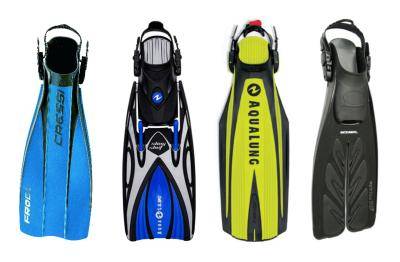
Definitely the most popular and versatile fin pocket type, open heeled fins are equipped with straps that hold the fin in placed.
Photo credit: http://scuba.about.com/
Compared to the closed heel fins, open heeled fins have wider and larger foot pockets. This is for the fact that open heeled fins are designed to be used with dive booties. Aside from protecting your feet from blisters and cuts, booties also keep your feet warm.
Open heeled fins are best for cold water diving. It is also best for beach or shore entry diving, wherein a diver needs to walk through stairs, sand, rubbles and even rocks to get to the dive site.
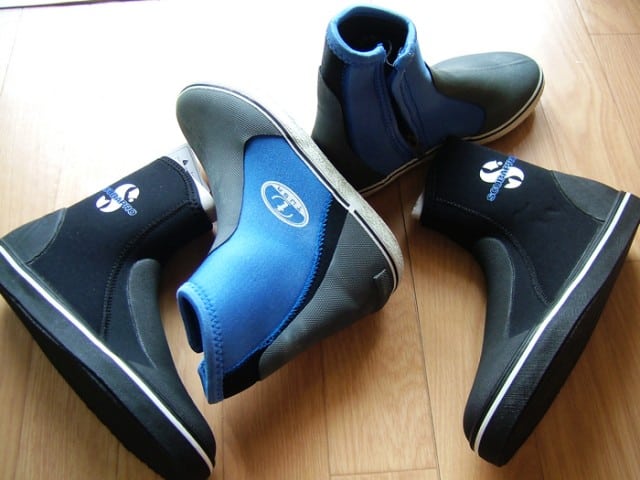
Wearing of diving boots are recommended when using the open heeled fins since its pockets are made of sturdy and hard materials.
Photo credit: http://happydiving.blogspot.com/
Although these fins are made of strong materials, please be advised that its strap is the weakest part. So always keep a spare strap to replace in case it breaks.
Closed Heeled (Full Foot) Fins
Closed heel fins are considered as traditional fins. In spite of the availability of new modern styled and designed fins, this pocket type is still popular among snorkelers and divers. These fins are generally more affordable and less expensive than the open heeled fins.

Closed heel (full foot) fins have smaller foot packet compared to the open heeled fins. These fins requires no dive booties since it can be worn by just slipping your foot inside its pockets.
Photo credit: http://www.scubawarehouse.com.sg/
Since it offers no thermal protection at all, closed heel fins are really best for warm water diving only. A few downsides of these fins are that they are not adjustable, you cannot use them in cold water and that they can cause blisters and cuts to your foot. Ouch! And even worse, they might also slip off your feet while swimming or moving.
Types of Diving Fins
Paddle fins
Paddle fins are considered as the traditional and simple fins. They can either be open heeled or closed heeled. Scuba divers usually prefer the open heeled ones due to adjustability and versatility, while closed heeled types are generally worn by swimmers or snorkelers.
Photo credit: http://dipndive.com/
Paddle fins basically move in an ‘up and down’ motion. This motion is very helpful in both free diving and diving in sites with currents. If you have strong legs then paddle fins are just perfect for you!
Split Fins
Split Fins are fins that are literally split into two parts. If you want to move swifter and faster underwater then split fins are your thing!

The difference between Split Fins and Paddle Fins? Split Fins literally have a split and have been divided into two parts.
Photo credit: http://aquaviews.net/
In contrast with the up and down movement of paddle fins, split fins act more like a boat propeller. These fins are split in specialized angles that makes every diver’s kick efficient and forceful without the use of too much effort, meaning that you can spend much more bottom time and cover a greater area with these fins. So what more could you ask for?
Force Fins
Want to have that great powerful kick underwater? Want to swim as fast as the surrounding tunas and dolphins? Then force fins are the fins for you!
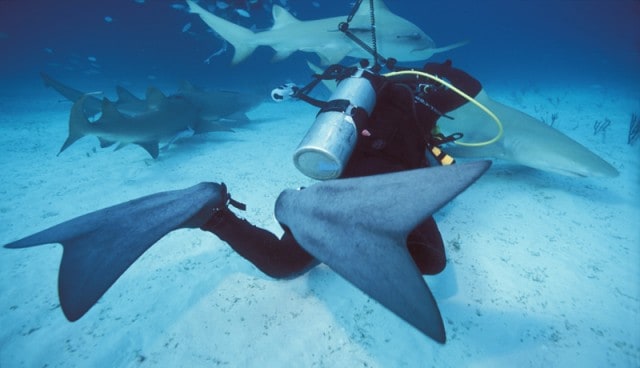
Forced Fins apparently are designed to imitate the tail of fast swimmers like the tuna and whales. No wonder it allows swift movement underwater.
Photo credit: http://captainblacks.net/
Although Force Fins appear smaller than the usual diving fins, these offer divers faster and swift underwater movement with very minimal kicking effort. Some may find these funs a bit funny looking. 
Want to know the history of the Force Fin? Check out this video now!
Flippable Fins
Probably the newest, most versatile and peculiar style of fins available in the market… the flipabble fins!
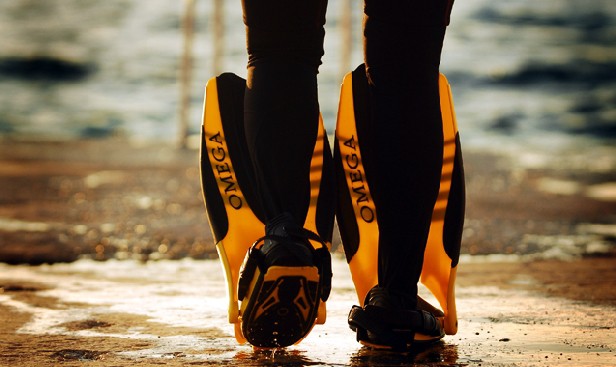
Flipabble fins are the only diving fins that can be flipped or folded. Thus, allowing divers to freely walk on shores or anywhere.
Photo credit: http://kusubaqua.com/
The fin’s blades can be flipped and folded out of the way, thus allowing divers to walk on the surface without removing their fins. This is very beneficial and convenient to those divers who need to walk down or climb ladders to get on and off the water. What makes these fins amazing is that its blades automatically flip down and lock into place once you start kicking in the water.
How to Fit Diving Fins
- First, sit down and wear the fins. Wear dive boots if you are to try the open heeled fins and make sure that you can see a few inches of your boots protruding from the foot pocket. Whereas a closed heeled fin will snug and fit comfortable on your barefoot.
- Move, shake and tilt your feet. This is to make sure that the fins are fit and tight enough. When trying the open heeled fins, never pull the strap too much and make sure that strap holds your foot in place
- Raise a fin and try to hold its tip. Then try flexing the fin as if you are kicking it underwater.
- You need to look for a fin with smaller pockets if the fin slips off your feet or your heel pops out every now and then whenever you move.
With an abundance of fins to choose from, it can be daunting and difficult to decide which one is best for you. But let’s keep it simple… no matter what type of diving fins you have, the most important thing to consider is COMFORT. Diving fins can either make or break that dive adventure you have been dreaming of. Therefore it should serve in making your diving experience an easy and hassle-free one. Happy diving everyone! 
 Destinations
Destinations





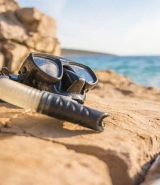




Great and very informative article! After reading your article, I realized I don’t know everything about fins. Haha! Yes, I have to agree with you, Jean. We may look funny and awkward under the water while wearing those fins but they are vital in keeping us last longer while interacting with the awesome creatures. Personally, I prefer wearing split fins because they allowed me to move faster especially in deeper areas.:-)
Hi admin,
For divers, it’s important to have the right diving fins. It is really interesting to see how diving fins have changed in last couple of years. Thanks for sharing!!!!
Pingback: Eagle Point Beach Resort in Batangas : Scuba Diving Blog: How to Choose Dive Fins? : Discount Vouchers | Travel and Tour Batangas | Your Deal Is Here
Nice Explanation. Thank you for sharing.
I am searing for the flippable fins, please tell me were to buy them. The link doesn’t work
Which is better for conserving energy, split or forceful fins?
Thanks for this! I am interested in how fin design relates to how fish swim. It seems to me that the paddle fin is stiff, to provide power like a dolphin of a shark tail. A skin-diving fin is springy, like the tail of pelagic fish, to achieve efficiency and an oscillating fin is floppy to provide speed like a squid or a seal. I was fascinated by the open toe design to reduce the strain of the ankle. How does that work? LINK REMOVED